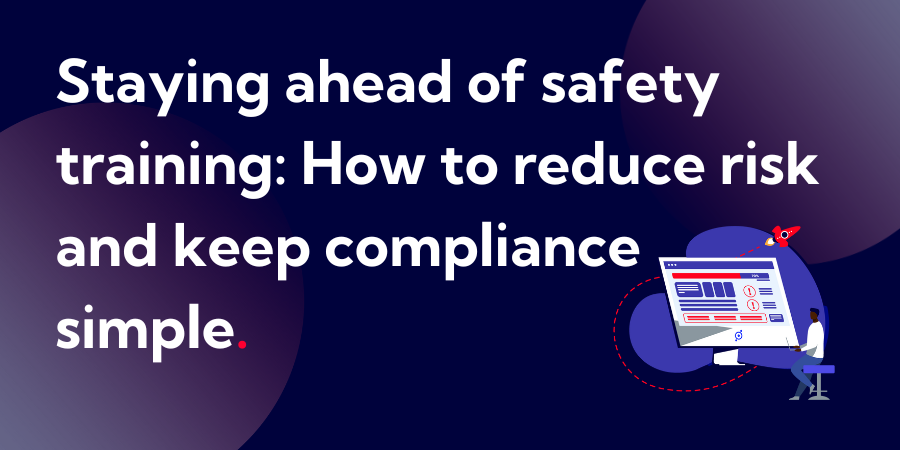Staying ahead of safety training: How to reduce risk and keep compliance simple

In safety-critical industries, training never really stops. Whether it’s construction, plant operations or health and safety, every role depends on the right qualifications, valid certificates and up-to-date records.
The real challenge is keeping track of it all.
Between last-minute course changes, expired licences and missing paperwork, even the most organised training providers can end up firefighting. It’s not that the processes don’t exist, it’s that they live across too many systems, spreadsheets and inboxes to stay consistent.
But compliance doesn’t have to feel chaotic. When training management is centralised and automated, safety and simplicity go hand in hand.
In this article, we’ll cover:
- The never-ending training cycle
- When admin errors become compliance risks
- Turning risk reduction into routine
- Why simplicity builds trust
- Building safety into every process
The never-ending training cycle
Safety training is never a one-off exercise. Forklift drivers need requalifying. Supervisors need refreshers. Site workers need inductions every time a new project begins.
For most training providers, this cycle runs continuously across hundreds or even thousands of learners. Add in trainers, venues, machinery and accrediting bodies, and the admin load multiplies quickly.
When renewal dates live in spreadsheets or inbox reminders, things inevitably slip. Someone forgets to rebook a refresher course. A certificate expires before it’s renewed. A report isn’t updated until the end of the month.
One small oversight can turn into a big operational setback. Missed requalifications can delay work on site, trigger audit issues or even invalidate insurance. And for providers with major clients, it can put valuable contracts at risk.
Proactive management, not reactive firefighting, is key to keeping your training business compliant and confident.
When admin errors become compliance risks
In training, small admin mistakes can have big consequences. Losing a certificate, missing an expiry date or failing to verify trainer competence doesn’t just cause headaches. It creates risk.
Here’s what that looks like day to day:
-
Tracking expiry dates manually. Even the most careful admin team can miss one learner in a thousand.
-
No shared visibility. Trainers, managers and coordinators working from different versions of a schedule or spreadsheet.
-
Slow reporting. Scrambling for data at audit time rather than having it ready instantly.
When these cracks start to appear, it’s not just compliance at stake. It’s reputation. Clients rely on you to deliver consistent, safe, accredited training. A single gap in records can undermine that trust.
And for internal teams, it’s exhausting. Chasing paperwork, reissuing certificates and manually checking qualifications all add hours of work each week.
But it doesn’t have to be this way.
Turning risk reduction into routine
Risk management becomes much easier when it’s built into your day-to-day processes.
With the right system in place, compliance becomes something that happens automatically rather than something that is constantly chased.
Here’s how training providers are doing it:
-
Automated expiry alerts keep trainers, clients and learners informed well before deadlines hit, giving everyone time to act.
-
Digital automated certificates eliminate lost paperwork and reduce duplicate requests.
-
Centralised learner and trainer records mean every qualification, skill and booking is linked and visible in real time.
-
Audit-ready reporting makes it simple to evidence compliance at the click of a button.
When training operations run through one connected platform, everything updates instantly. Change a course date and it updates for every stakeholder. Add a qualification and it appears in the learner record immediately.
The value comes from both the time saved and the confidence that everything’s in hand. Everyone sees the same information, knows where things stand and can focus on delivering great training instead of chasing admin.
Why simplicity builds trust
For safety training providers, reputation is everything. Clients want to know they can rely on you. Auditors want to see clear evidence. Trainers want to work with accurate, up-to-date schedules.
A smooth, visible training management process builds confidence across the board.
-
Clients get assurance that learners are qualified and records are in order.
-
Trainers can trust the schedule and focus on delivery.
-
Admin teams spend less time chasing and more time improving service.
The more straightforward your system, the easier it is to demonstrate compliance and the stronger your professional reputation becomes.
At the same time, simplicity helps your business scale. When everything from booking to certification is automated, taking on new clients or courses doesn’t mean doubling your workload.
Building safety into every process
At its core, safety training is about risk prevention, and that should extend to the way training is managed. Manual admin, disconnected tools and lost paperwork are all risks in themselves.
By building automation and visibility into your processes, you create a safety net that protects your team, your learners and your business. You reduce the chance of errors, keep records consistent and gain full confidence that every learner, trainer and course is exactly where it should be.
In summary
Staying compliant doesn’t have to add to your workload. When your training management processes are connected, from bookings and certificates to reporting, you save time, reduce admin and strengthen your reputation.
In safety-focused industries, small improvements in efficiency can have a big impact. A connected system helps you stay organised, gives your team confidence in the accuracy of their data, and ensures nothing slips through the cracks. Clients see that you’re in control, trainers have the information they need, and your admin team spends less time chasing paperwork and more time supporting delivery.
When compliance becomes part of everyday operations rather than an extra task, you create a smoother, more reliable training experience for everyone involved.
Want to stay up to date with what we're up to? Subscribe to our blog or follow us on Instagram!

..png?width=270&height=170&name=The%20hidden%20costs%20of%20training%20management%20(and%20how%20to%20fix%20them)..png)
.png?width=270&height=170&name=choosing%20training%20methodology%20(1).png)
-1.png?width=270&height=170&name=website%20blog%20images%20(2)-1.png)